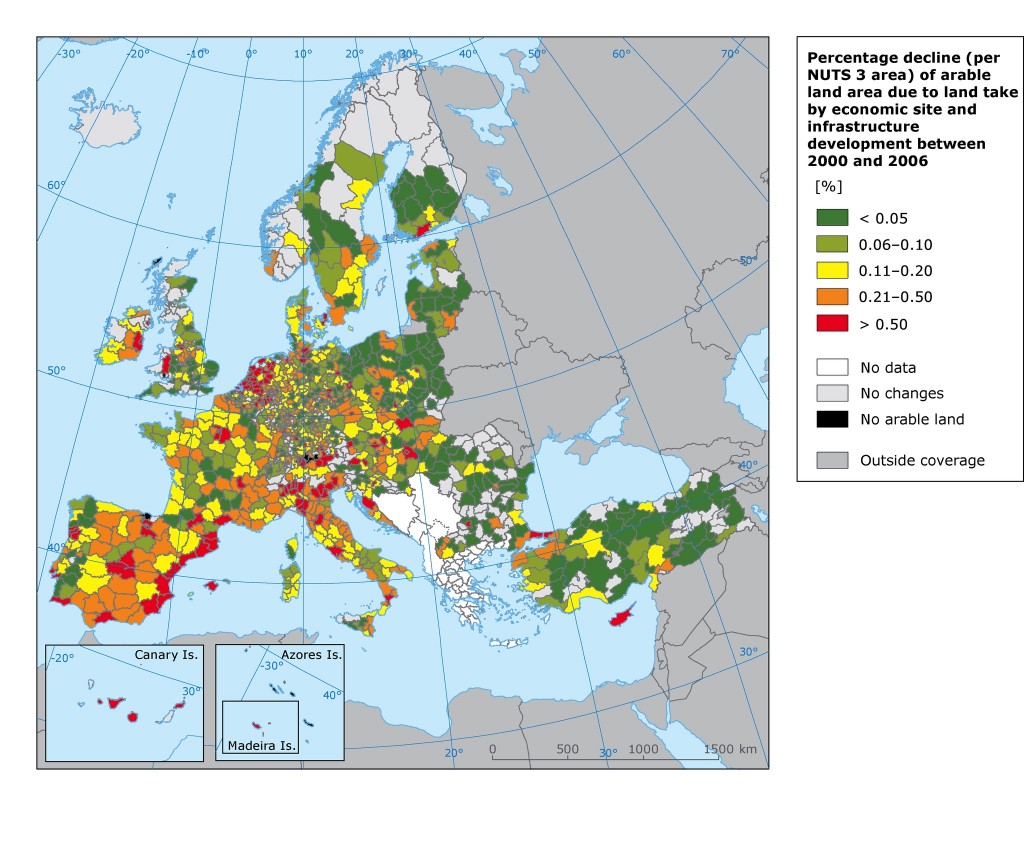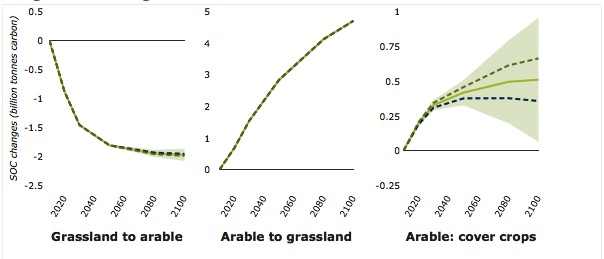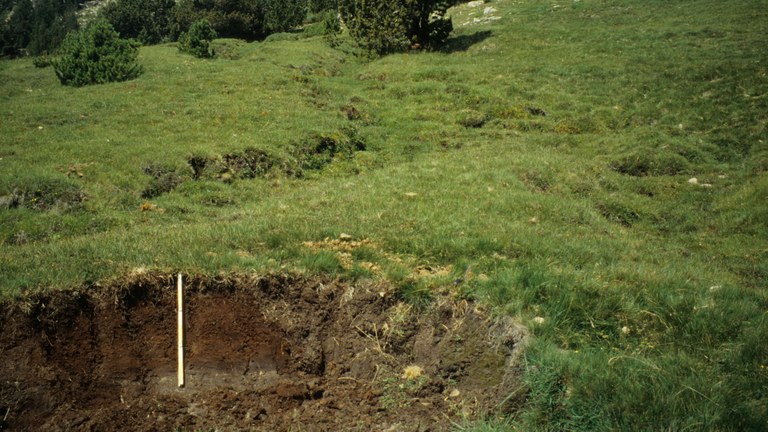Origen: Soil — EEA´s SOER2015
The ability of soil to deliver ecosystem services — in terms of food production, as biodiversity pools and as a regulator of gasses, water and nutrients — is under increasing pressure. Observed rates of soil sealing, erosion, contamination and decline in organic matter all reduce soil capability. Organic carbon stocks in agricultural soil may have been overestimated by 25%.
A coherent soil policy at EU level would provide the framework to coordinate efforts to survey soil status adequately.
Context
The degree to which society can benefit from soils is dependent on how it uses and manages them. Soils that are sealed for urban development or transport infrastructure lose most of their functions due to disrupted water, nutrient, and biological cycles. This loss is close to irreversible [1]
Equally, soils can be degraded by the interplay of human and natural processes that cause decline in organic matter and biodiversity, compaction, and erosion by wind and water. Mineral or groundwater extraction can lead to pollution and affect soil stability, even causing subsidence in some urban areas; while large-scale drilling for shale gas productionmay add to existing contamination processes.
These phenomena affect the delivery of soil-based ecosystem services and can be costly or difficult to resolve. In recognition of these pressures and the importance of soil functions, the European Commission launched a Thematic Strategy on soil, which called for the protection and sustainable use of soil [2] while highlighting several vital soil functions: providing biomass and raw materials; storing, filtering and transforming substances; and acting as a carbon and biodiversity pool, as a platform for human activities and the landscape, and as an archive of heritage.
Soils received further recognition when the UN Rio+20 Summit [3] highlighted soil degradation as part of land degradation, and called for a land-degradation-neutral world in the context of sustainable development, a goal to which the EU subscribed. This target is reiterated in the European Union’s 7th Environment Action Programme (7th EAP) [4]
Converting broad policy positions into action requires increased efforts and related targets to reduce soil erosion, to increase soil organic matter and preserve soil biodiversity, to remediate contaminated sites, and to limit soil sealing.
Key trends
Quantifying soil-based ecosystem services, in terms of the physical services provided and their economic value, is a relatively recent research area. While it is currently not possible to describe trends in soil functions, some baseline data are available at pan-European level [5]. More detailed data may exist at national levels.
Biomass production as a provisioning service of soil
Soils are used to produce a range of biomass products that serve as food, feed, fibre and fuel. Biomass production can be particularly relevant in biodiversity conservation and climate change mitigation efforts, through supporting elements of ‘green infrastructure’ [6][7] and flood regulation.
An EU-27 baseline study of biomass production under arable land, grassland [8] and woodland [9] showed that on arable land, local soil quality determines to a greater extent the variability of the biomass production potential than climate. Thus, in most regions, well-managed arable land that preserves the soil quality can compensate for climatic handicaps. However, in the Mediterranean area, good management may not be sufficient to make up for climatic limitations.
Three other factors that affect biomass production are soil management (including irrigation and fertilisation), soil degradation processes (e.g. soil erosion) and ‘land take’ [10]. From 2000 to 2006, 0.26% of the production potential on arable land in the EU-27 was lost as a consequence of land take [11][12]; over the period 1990–2006, this loss amounted to 0.81% [13]. Map 1 illustrates the issue in relation to industrial and commercial sites plus transport networks and indicates some hotspots.

Soil organic carbon pool as a regulating service of soil
A key service provided by soil is the storage and release of organic matter and carbon. Soil organic matter is essential for biomass production and for sustaining biodiversity. Soils can offset other greenhouse gas emissions by capturing and storing carbon, and they can help to adapt to climate change (e.g. in flood regulation owing to the structuring effect of soil organic matter).
Soil organic carbon (SOC) stocks in the EU-27 have been estimated at 75–79 billion tonnes [14][15]. Modelling results from the CAPRESE project suggest that prior assessments may have overestimated the SOC pool in agricultural topsoils [16] by around a quarter [17][18]. This highlights the need for systematic monitoring and the even greater importance of soil organic matter conservation.
The removal of topsoil by erosion is a worrying phenomenon as it impacts on SOC stocks and causes various off-site issues (e.g. siltation [19] of water bodies) [20]. A recent study estimated that 130 million ha were affected by water erosion in the EU-27 [15]. Improvements in modelling [21][22] are leading to higher precision in erosion estimates [23][24]
Storage, filtration and transformation as a supporting service of soil
Soil stores, filters and transforms a range of substances including nutrients, contaminants, and water. In this context, soils act as a biological engine, controlling many key natural life cycles. In parallel, this function in itself implies potential trade-offs: a high capacity to store contaminants may prevent groundwater contamination, but this retention of contaminants may be harmful for biota.
The issue of contamination is crucial for this function as both diffuse and point source pollution [25] can impact human health and ecosystem services, thus affecting a soil’s capacity to ‘regenerate’. On the basis of non-harmonised national inventories, local soil contamination in the EEA-33 plus the 6 cooperating countries has recently been estimated at 2.5 million potentially contaminated sites [26]. About one third of an estimated total of 342 000 contaminated sites in the EEA-33 plus the 6 cooperating countries have already been identified and about 15% of these have been remediated. However, there are substantial differences in underlying definitions and interpretations in different countries.
The intensity of soil use can considerably influence soil organisms, which in turn drive nutrient cycling [27]. High-intensity arable land results in lower diversity and biomass of soil organisms compared to land that is less-intensively cultivated or under permanent grassland [28]
Prospects
As local soil quality largely determines biomass production potential on arable land, nutrient status plays a defining role. Soil fertility is the result of inherent soil characteristics (such as texture), nutrient inputs, and other management practices, which may strongly influence nutrient cycling. Europe-wide harmonised measurements of particular soil characteristics from the LUCAS Topsoil [29][22] and GEMAS [30] projects provide a picture of both the inherent characteristics of the soil and a signature of past soil use and management. Time series of soil characteristics, as expected from the continuation of the LUCAS Topsoil Survey, are required to assess changes and trends in biomass productivity.
The CAPRESE study found that the conversion of arable land to grassland is the most rapid method to gain SOC (Figure 1). Under future scenarios of arable land management, the use of cover crops [31] was found to be the most effective way of increasing SOC, although the effects are markedly regional due to climate. Such findings could be useful for estimating carbon emissions and removals from agricultural land in the context of LULUCF [32]. These results reinforce the message that land management is crucial in protecting, maintaining and improving the delivery of soil-based ecosystem services. This becomes even more relevant when considering that 40% of the EU area is agricultural land, managed in line with Common Agricultural Policy provisions that require land to be maintained in good agricultural and environmental condition. However, in the event of poor policy implementation, continued soil function loss is expected.

The lack of good-quality and harmonised soil data at pan-European scale, and the relatively undeveloped state of research on linking soil data with soil functions, makes it difficult to assess the prospects for soil functionality and soil-based ecosystem services. Only when robust baselines and a harmonised soil monitoring framework (addressing relevant soil functions and degradation processes) are in place can regular updates on trends be expected. Despite some promising projects, activities are clearly insufficient to deliver a comprehensive information and knowledge base to adequately support policy making in this area. Further research is thus needed to manage soils sustainably in the future. A binding and coherent soil policy at EU level would provide the framework to do so.
References and footnotes [1] EC (2012), Commission Staff Working Document Guidelines on best practice to limit, mitigate or compensate soil sealing (SWD(2012) 101 final/2 of 15 May 2012), accessed 30 June 2014. [2] EC (2006), Communication from the Commission to the European Parliament, the Council, the European Economic and Social Committee and the Committee of the Regions Thematic Strategy for Soil Protection (COM(2006)231 final of 22 September 2006), accessed 30 June 2014. [3] UNGA (2012), The Future We Want, accessed 26 June 2014. [4] EU (2013), Decision No 1386/2013/EU of the European Parliament and of the Council of 20 November 2013 on a General Union Environment Action Programme to 2020 'Living well, within the limits of our planet' (OJ L 354/171, 28.12.2013). [5] See for example the EU Agri-environmental indicator — soil quality. [6] Green infrastructure: a way to work with nature to provide social, ecological and economic benefits (such as air quality, temperature regulation, noise reduction, flood protection and recreational areas) to the (urban) population.[7] [7] EC (2013), Communication from the Commission to the European Parliament, the Council, the European Economic and Social Committee and the Committee of the Regions 'Green Infrastructure (GI) — Enhancing Europe's Natural Capital' (COM(2013) 249 final of 6 May 2013) [8] Including pastures. [9] Tóth, G., Gardi, C., Bódis, K., Ivits, E., Aksoy, E, Jones, A., Jeffrey, S., Petursdottir, T. and Montanarella, L. (2013), 'Continental-scale assessment of provisioning soil functions in Europe', Ecological Processes, (2013, 2) 32. [10] Land take: new development of the so-called 'urban fabric' which comprises industrial, commercial and transport units; mines, dumping and construction sites; and green urban areas and sport and leisure facilities (see SOER 2015 on Land systems). [11] Tóth, G. (2012), 'Impact of land take on the land resource base for crop production in the European Union', Science of the Total Environment, (435–436) 202–214. [12] Tóth, G., Bódis, K., Ivits, É., Máté, F. and Montanarella, L. (2011), 'Productivity component of the proposed new European agri-environmental soil quality indicator', in: Tóth, G. and Németh, T. (eds.),Land quality and land use information in the European Union, European Commission, Joint Research Centre, Luxembourg. [13] Gardi, C., Panagos, P., Van Liedekerke, M., Bosco, C. and de Brogniez, D. (2014), 'Land Take and Food Security: Assessment of land take on the agricultural production in Europe', to be published in Journal of Environmental Planning and Management, accessed 9 January 2015. [14] Jones, R.J.A., Hiederer, R., Rusco, E., Loveland, P.J. and Montanarella, L. (2004), The map of organic carbon in topsoils in Europe, Version 1.2, September 2003: Explanation of Special Publication Ispra 2004 No.72 (S.P.I.04.72), European Soil Bureau Research Report No 17, European Commission, Joint Research Centre, Luxembourg. [15] EEA (2012), Climate change, impacts and vulnerability in Europe 2012, EEA Report No 12/2012, European Environment Agency, accessed 30 June 2014. [16] Topsoil: the most fertile portion of soil generally lying between 0-30 cm below ground. [17] Lugato E., Panagos, P., Bampa, F., Jones A. and Montanarella, L. (2014), 'A new baseline of organic carbon stock in European agricultural soils using a modelling approach', Global change biology, 20 (1) 313–326. [18] Lugato, E., Bampa, F., Panagos, P., Montanarella, L. and Jones, A. (2014), 'Potential carbon sequestration of European arable soils estimated by modelling a comprehensive set of management practices', Global Change Biology, 20 (11) 3557–3567.
[19] Siltation: the pollution of water by fine terrestrial material, with a particle size dominated by silt or clay. It refers both to the increased concentration of suspended sediments, and to the increased accumulation (temporary or permanent) of fine sediments on bottoms where they are undesirable.
[20] See EU Agri-environmental indicator — soil erosion.
[21] These improvements include the incorporation of the results from the 2009 LUCAS Topsoil survey.[22] Water erosion is defined by five factors: rainfall erosivity, soil erodibility, topography (slope length and steepness), land cover/vegetation, and management practices. In addition to the soil erodibility factor, JRC is currently developing an update of the other layers as well.
[22] Tóth, G., Jones, A. and Montanarella, L. (eds.) (2013), LUCAS Topsoil Survey – methodology, data and results, JRC Technical Reports, European Commission, Joint Research Centre, Luxembourg, accessed 30 June 2014.
[23] Panagos, P., Meusburger, K., Alewell, C., Montanarella, L. (2012), 'Soil erodibility estimation using LUCAS point survey data of Europe', Environmental Modelling & Software, (30) 143–145.
[24] Panagos, P., Meusburger, K., Ballabio, C., Borrelli, P. and Alewell, C. (2014), 'Soil erodibility in Europe: A high-resolution dataset based on LUCAS', Science of Total Environment, (479–480) 189–200.
[25] Diffuse pollution can come from many sources while point source pollution comes from a single source.
[26] Van Liedekerke, M., Prokop, G., Rabl-Berger, S., Kibblewhite, M. and Louwagie, G. (2014), Progress in the management of Contaminated Sites in Europe, JRC Reference Reports, European Commission, Joint Research Centre, Luxembourg, accessed 30 June 2014.
[27] Nutrient cycling: exchanges of nutrients between different parts of an ecosystem by chemical, physical and biological processes.
[28] de Vries, F. T., Thébault, E., Liiri, M., Birkhofer, K., Tsiafouli, M. A., Bjørnlund, L., Bracht Jørgensen, H., Brady, M. V., Christensen, S., de Ruiter, P. C., d'Hertefeldt, T., Frouz, J., Hedlund, K., Hemerik, L., Gera Hol, W. H., Hotes, S., Mortimer, S. R., Setälä, H., Sgardelis, S. P., Uteseny, K., van der Putten, W. H., Wolters, V. and Bardgett, R. D. (2013), 'Soil food web properties explain ecosystem services across European land use systems', Proceedings of the National Academy of Sciences, (110) 14 296–14 301.
[29] The LUCAS (i.e. Land Use/Cover Area Frame Survey) Topsoil project covers 25 EU Member States that were sampled in 2009.[22]
[30] In the GEMAS (GEOCHEMICAL MAPPING OF AGRICULTURAL AND GRAZING LAND SOIL) project soil was sampled on arable and grazing land in 34 European countries in 2008–2009.
[31] Cover crops: crops grown to increase soil fertility and avoid soil erosion in between (cash) crop harvests.


 Aragonese
Aragonese English
English Spanish
Spanish